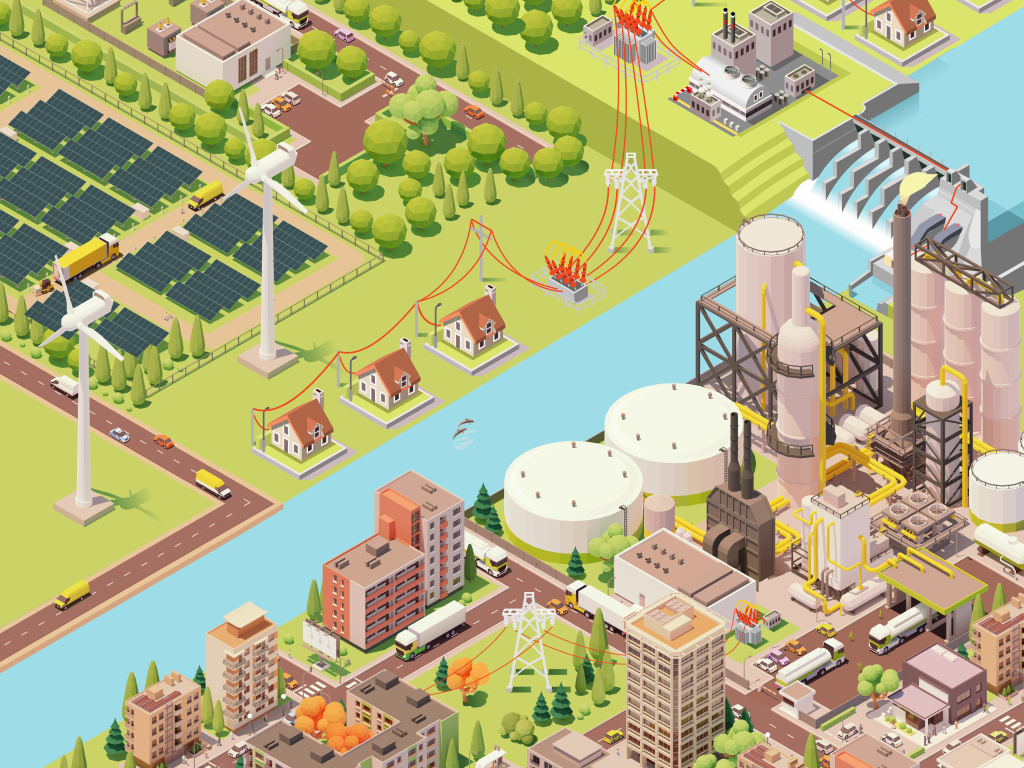Agent-based Simulation of Transition Scenarios for regional Heating and Energy Transformation
ABM4EnergyTransition
For an English version see below
Unsere Energieversorgung befindet sich in einem rasanten Umbruch. Neue Technologien und Möglichkeiten wie die Elektromobilität, Digitalisierung, Energiegemeinschaften oder Niedertemperatur-Wärmenetze drängen in den Markt, die in Einklang gebracht werden müssen mit gesellschaftlichen Forderungen nach mehr Nachhaltigkeit, wirtschaftlichen Rahmenbedingungen und politischen Bekenntnissen wie der österreichischen Wärmestrategie (Dekarbonisierung der Wärmeversorgung von Gebäuden bis 2040). Diese Komplexität stellt vor allem die Politik, aber auch die Akteure in Energieversorgung und Wirtschaft vor große Herausforderungen. Eine energieeffiziente und klimafreundliche Wärmeversorgung der Zukunft erfordert nun planvolles und umsichtiges Handeln, die eine Modernisierung des Gebäudebestandes, eine nachhaltige Ausrichtung von Neubauten sowie die Umstellung der Wärme- und Kälteversorgung auf erneuerbare Energieträger ermöglicht und unterstützt. Neben der technischen und räumlichen Dimension der Energiewende muss auch der sozialen Dimension bei Planungs- und Entscheidungsfindungsprozessen zunehmende Wichtigkeit beigemessen werden. Die Verhaltensweisen und Entscheidungsmuster zentraler Akteure (Politik, öffentliche Verwaltung, Planer, Investoren, Energieversorgungsunternehmen, Bevölkerung) sind im Kontext der Wärme- und Energiewende höchst planungsrelevant, werden jedoch in aktuellen Prozessen kaum bis gar nicht berücksichtigt. Die Integration dieser Aspekte wird in dem avisierten Vorhaben adressiert und so bestehende Planungsansätze und -tools um essentielle Elemente ergänzt.

Konkretes Projektziel ist die Entwicklung und Demonstration eines neuartigen Simulationsmodelles zur Darstellung und Bewertung von Transformationspfaden für die kommunale Wärme- und Energiewende. Diese Methodik berücksichtigt sowohl räumlichen Daten zur Beschreibung des Energiesystems eines Untersuchungsgebietes (Gebäude, leitungsgebundene Infrastruktur, erneuerbare Potenziale, etc.) als auch Parameter zur Beschreibung des Verhaltens der Akteure innerhalb dieses Energiesystems (Hauseigentümer, Investoren, politische Entscheidungsträger) in Abhängigkeit demografischer und sozio-technischer Parameter, wie z.B. Einkommen und Bildungsstand. Dieser Ansatz stellt eine Erweiterung bestehender energietechnischer Planungsansätze dar und ermöglicht mitunter die Wirkungsfolgenabschätzung von energiepolitischen Maßnahmen auf die Erreichung von Klima- und Energiezielen. Als Projektergebnis wird am Beispiel von zwei konkreten Untersuchungsgebieten eine prototypische Web-Applikation mit Kartendarstellung der Gebäude und Energieinfrastruktur inkl. Dashboard entwickelt, die es den NutzerInnen aus Verwaltung und Planung erlaubt, mögliche energiepolitische und/oder technische Interventionen zu planen und die entsprechenden Ergebnisse (z.B.: Energie- und Ökobilanz, Technologie- und Energieträgermix in variabler räumlicher und zeitlicher Granularität) zu visualisieren und zu analysieren. Die Ergebnisse können zur weiteren planerischen Verwendung, z.B. in der Energieraumplanung oder der Fernwärmeausbauplanung, exportiert und im eigenen GIS-System nutzbar gemacht werden. Zudem können vereinfachte Simulationsszenarien auch von interessierten BürgerInnen in der Web-Applikation für eine spielerische Auseinandersetzung mit dem Thema Wärmewende und Systemwandel initialisiert und visualisiert werden.
Our energy system is undergoing rapid change. New technologies and opportunities such as electromobility, digitization, energy communities or low-temperature heating networks are entering the market, which must be reconciled with societal demands for greater sustainability and political commitments such as the Austrian heating strategy with the goal of decarbonizing the heat supply for buildings by 2040. This poses a high level of complexity for decision-makers in politics, energy supply and business. An energy-efficient and climate-friendly heat supply of the future now requires planned action, the modernization of the existing building stock, a sustainable orientation of new buildings, and the conversion of the heating and cooling supply to renewable energy sources. Not only will infrastructure and technology change, but the use of buildings will also be transformed by digitalization, and administrative as well as planning processes must do justice to this system complexity. In addition to the spatial dimension of energy supply and demand, increasing importance must also be attached to the social dimension of the energy transition in planning and decisionmaking processes. The behaviors and decision-making patterns of central actors (politics, public administration, planners, investors, energy supply companies, population), each with their own specific roles, needs and values, are highly relevant to planning in the context of heat and energy transition, but are, if at all, hardly considered in current processes. This combination and integration will be addressed in the planned project complementing existing (spatial) planning approaches and tools by essential elements.
The concrete project objective of ABM4EnergyTransition is the development and demonstration of a novel simulation approach based on agent-based modeling (ABM) for the spatial analysis and assessment of pathways for the municipal heat and energy transition. The ABM methodology considers both spatial data to describe the energy system of a study area (buildings, grid-based energy infrastructure such as natural gas or district heating networks, renewable potentials, population structure) and parameters to describe the behavior of actors (agents) within this energy system (homeowners, investors, policy makers) taking into account demographic and socio - technical parameters such as income and state of education. The methodological approach represents an extension of existing energy planning approaches and helps to better assess the impact of public policies on the achievement of climate and energy goals. The tangible project result will be a prototypical web application with map representation of buildings and energy infrastructure incl. dashboard using two study areas, which allows users from administration and planning to plan possible energy policy and/or technical interventions in the ABM and to display the results (e.g.: Energy and Life Cycle Assessment as well as technology and energy carrier mix in variable spatial and temporal granularity, etc.). The results can be exported for further planning use, e.g. in energy space planning or district heating expansion planning, and in a local GIS system. In addition, simplified simulation scenarios can also be initialized and visualized by interested citizens in the web application for a playful examination of the topic of heat transition and energy system change.
Duration of the project: 01 November 2022 - 31 October 2024
Partners

- Paris Lodron Universität Salzburg
- AEE INTEC
- École Polytechnique Fédérale de Lausanne, Laboratory on Human-Environment Relations in Urban Systems
- Energieagentur Stmk gGmbH
- Moving Layers GmbH
- Stadtgemeinde Kapfenberg
Acknowledgements
This project is funded by Österreichische Forschungsförderungsgesellschaft mbH, FFG (Österreich) within the programme “AI for Green 2021” (Project Number FO999892237)